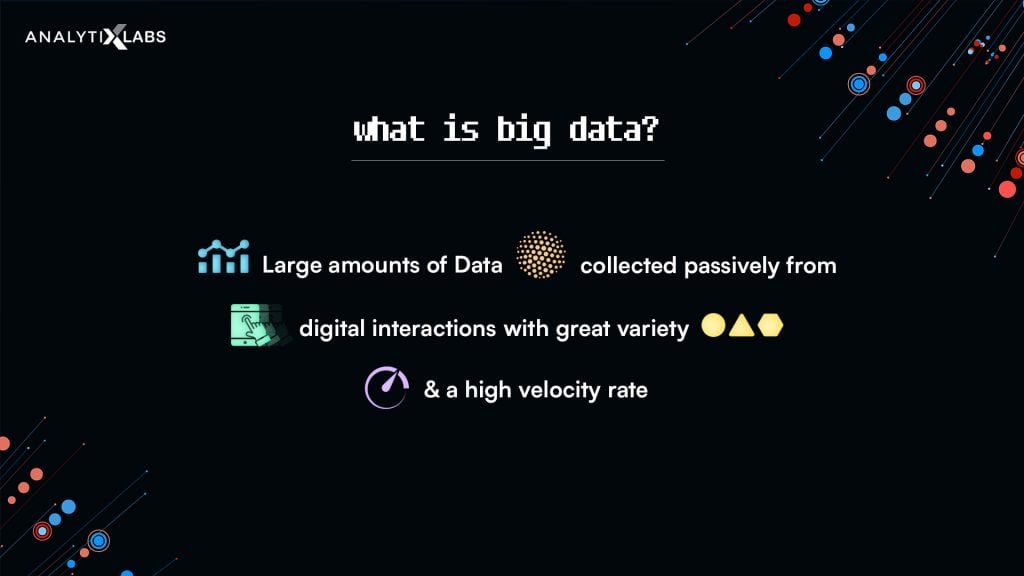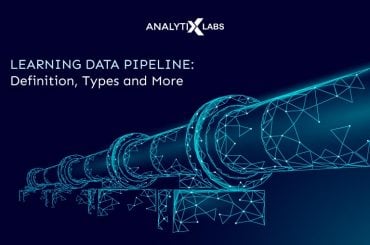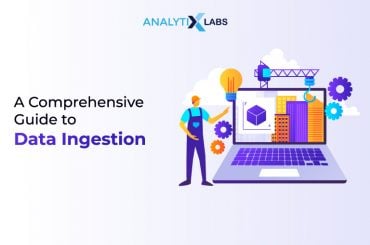Big Data is among the fastest-growing sectors globally. It refers to collecting and analyzing large amounts of data to generate actionable insights that an organization uses to enhance its different aspects. It is a broad concept with numerous advantages. This is why companies in various sectors are focused on using this technology. To understand what is Big Data, you must get familiar with the big data core characteristics. Understanding the characteristics of Big Data Analytics will also help you understand the advanced concepts of this subject. In the following article, we’ll discuss the definition, characteristics of big data, its types, components, advantages, and latest insights.
Introduction
Big Data is among the hottest terms in the tech sector. If you’ve been keeping up with the industry trends, you must have heard of Big Data. Government organizations, businesses, healthcare providers, and many other enterprises focus on using Big Data to enhance their operations and drive their growth. Experts estimate that the entire digital universe reached 44 zettabytes by 2020, which means 40 times more bytes than there are stars in the universe. (Source)
Big Data allows companies and organizations to use large amounts of data effectively. It allows organizations to identify trends, patterns, and associations that would be quite challenging or nearly impossible to find with conventional data-processing solutions. As a result, there’s a huge demand for big data professionals. However, if you want to pursue a career in this field, you must first get familiar with Big Data characteristics and its fundamentals.
AnalytixLabs is among the leading higher education companies in India. They offer a wide array of big data and data analytics courses to help students emerge as industry-ready professionals. They have trained over 15,000 candidates and have an average rating of 9.7/10.
What Is Big Data? – In Short
Big Data is the field of analyzing and extracting information from extremely large data sets. The term also refers to large quantities of data that grow exponentially with time. Such data is so humongous and complex that no conventional methods or traditional data management tool can process and store it effectively. There are many examples of Big Data. From social media platforms to E-commerce stores, organizations in various industries generate and utilize data to enhance their processes.

Big data includes multiple processes, including data mining, data analysis, data storage, data visualization, etc. The term “big data” refers to collecting these processes and all the tools that we use during the same.
Types of Big Data
There are primarily three types of data in big data:
1. Structured
Structured data refers to the data that you can process, store, and retrieve in a fixed format. It is highly organized information that you can readily and seamlessly store and access from a database by using simple algorithms. This is the easiest type of data to manage as you know what data format you are working with in advance. For example, the data that a company stores in its databases in the form of tables and spreadsheets is structured data.
2. Unstructured
Data with an unknown structure is termed unstructured data. Its size is substantially bigger than structured data and is heterogeneous in nature. A great example of unstructured data includes the results you get when you perform a Google search. You get webpages, videos, images, text, and other data formats of varying sizes.
3. Semi-structured
As the name suggests, semi-structured data contains a combination of structured and unstructured data. It is data that hasn’t been classified into a specific database but contains vital tags that separate individual elements within the same. For example, a table definition in relational DBMS has semi-structured data.
Characteristics of Big Data
Following are the big data core characteristics. Understanding the characteristics of big data is vital to know how it works and how you can use it. There are primarily seven characteristics of big data analytics:

1. Volume
Volume refers to the amount of data that you have. We measure the volume of our data in Gigabytes, Zettabytes (ZB), and Yottabytes (YB). According to the industry trends, the volume of data will rise substantially in the coming years.
2. Velocity
Velocity refers to the speed of data processing. High velocity is crucial for the performance of any big data process. It consists of the rate of change, activity bursts, and the linking of incoming data sets.
3. Value
Value refers to the benefits that your organization derives from the data. Does it match your organization’s goals? Does it help your organization enhance itself? It’s among the most important big data core characteristics.
4. Variety
Variety refers to the different types of big data. It is among the biggest issues the big data industry faces as it affects performance. It’s vital to properly manage the variety of your data by organizing it. Variety is the various types of data you gather from various sources.
5. Veracity
Veracity refers to the accuracy of your data. It is among the most important Big Data characteristics as low veracity can greatly damage the accuracy of your results.
6. Validity
How valid and relevant is the data to be used for the intended purpose.
7. Volatility
Big data is constantly changing. The data you gathered from a source a day ago might be different from what you found today. This is called variability of data, and it affects your data homogenization.
8. Visualization
Visualization refers to showing your big data-generated insights through visual representations such as charts and graphs. It has become prevalent recently as big data professionals regularly share their insights with non-technical audiences.
Main Components of Big Data
1. Ingestion
Ingestion refers to the process of gathering and preparing the data. You’d use the ETL (extract, transform, and load) process to prepare your data. In this phase, you have to identify your data sources, determine whether you’ll gather the data in batches or stream it, and prepare it through cleansing, massaging, and organization. You perform the extract process in gathering the data and the transformation process in optimizing it.
2. Storage
Once you have gathered the necessary data, you’d need to store it. Here, you’ll perform the final step of the ETL, the load process. You’d store your data in a data warehouse or a data lake, depending on your requirements. This is why it’s crucial to understand your organization’s goals while performing any big data process.
4. Analysis
In this phase of your big data process, you’d analyze the data to generate valuable insights for your organization. There are four kinds of big data analytics: prescriptive, predictive, descriptive, and diagnostic. You’d use artificial intelligence and machine learning algorithms in this phase to analyze the data.
5. Consumption
This is the final phase of a big data process. Once you have analyzed the data and have found the insights, you have to share them with others. Here, you’d have to utilize data visualization and data storytelling to share your insights effectively with a non-technical audience such as stakeholders and project managers.
Learn more about what is Big Data Architecture, Its Types, Tools, and More?
Advantages of Big Data
There are numerous advantages of Big Data for organizations. Some of the key ones are as follows:
1. Enhanced Decision-making
Big data implementations can help businesses and organizations make better-informed decisions in less time. It allows them to use outside intelligence such as search engines and social media platforms to fine-tune their strategies. Big data can identify trends and patterns that would’ve been invisible otherwise, helping companies avoiding errors.
2. Data-driven Customer Service
Another huge impact big data can have on all industries is in the customer service department. Companies are replacing the traditional customer feedback system with data-driven solutions. Such solutions can analyze customer feedback more efficiently and help them offer customer service to the consumers.
3. Efficiency Optimization
Organizations use big data to identify the weak areas present within them. Then, they use these findings to resolve those issues and enhance their operations substantially. For example, Big Data has substantially helped the manufacturing sector improve its efficiency through IoT and robotics.
4. Real-time Decision Making
Big Data has transformed several areas by enabling real-time trackings, such as inventory management, supply chain optimization, anti-money laundering, and fraud detection in banking & finance.
Key Big Data Insights of 2022
Here are some key big data statistics that reflect the growth and impact of this field:

- The global Big Data market size is estimated to grow from $138.9 billion in 2020 to $229.4 billion by 2025. It’ll grow at an astonishing CAGR of 10.6% during this period. (Source)
- From 2020 to 2025, the big data industry in the Asia Pacific region will grow at the highest CAGR compared to other regions, including North America. (Source)
- 99.5% of collected data never gets analyzed, indicating there’s a lot of growth potential. (Source)
- Fortune 1000 companies can gain $65 million more net income by enhancing their data accessibility by just 10%. (Source)
- 300 new hours of video are uploaded to YouTube every minute, which is why they have more than 1 billion gigabytes of data on their servers. (Source)
- The average salary of a big data engineer in India is INR 7.88 lakh per annum. It ranges from INR 3.99 lakh per annum and can reach around INR 17 lakh per annum according to their skills and experience. (Source)
- Experts believe that the healthcare industry can benefit substantially from utilizing big data analytics. They estimate that this sector can save as much as $300 billion per year by using big data. (Source)
- The global revenue of business intelligence and analytics tools software solutions in 2018 was an astonishing $24 billion. (Source)
It’s clear from the above statistics that the Big Data industry is growing rapidly. We generate tons of data every day, and organizations recognize the value of this data. Therefore, harnessing the power of Big Data technologies can help multiple sectors in enhancing their growth.
Related
FAQs – Frequently Asked Questions
Q1. What are the 7 V’s of Big Data?
Many people believe that there are primarily three characteristics of Big Data – Volume, Velocity, and Variety. However, in a more modern outlook, there are 7 characteristics of Big Data, which are also called the 7 V’s of big data. They are as follows:
- Volume
- Velocity
- Variety
- Variability
- Veracity
- Visualization
- Value
For more details on this, please refer to the Characteristics of Big Data explained in the earlier section of this blog.
Q2. What is Big Data used for?
Big data helps organizations use the large quantities of data it generates and gathers from various sources. There are many big data applications, which is why it’s among the most in-demand skills currently. Some vital applications of big data are the following:
- Big data allows companies to generate more accurate insights. It gives them the capability to use relevant data from various sources to produce actionable insights. With better accuracy, a company can make more beneficial decisions and mitigate risks.
- Social media platforms generate a ton of data. Marketers use big data to utilize the data social media platforms have to create better promotional campaigns. It allows them to create precise customer profiles, find their target audience, and understand their requirements.
- Big data tools allow companies to perform predictive analysis. It enables them to predict the results of specific processes and events more accurately, helping them mitigate risk.
- Another prominent application of big data is in recommendation systems. Companies use big data to identify behavior patterns in their customers to offer better and more personalized services.
For more details, you may also like to read: Understand more What Is Big Data Analytics? Know Its Importance & Uses
Q3. What are the main components of Big Data?
A Big Data system must have the following four components:
- Ingestion (collecting and preparing the data)
- Storage (storing the data)
- Analysis (analyzing the data)
- Consumption (presenting and sharing the insights)
Without any one of these components, your big data implementation would be incomplete. Primarily, you should have a component for gathering the data and another for storing it. You would also need an analytics solution and, finally, a reporting solution in your big data ecosystem.
You may also like to read: What is Modern Big Data Engineering? Role, Skills, Job & Salary
Conclusion
Big Data is among the most in-demand technologies currently. Companies of various industries are looking for ways to utilize Big Data to enhance their operations, attract more customers, and get ahead of their competitors. The first three characteristics of big data are volume, velocity, and variety. Additional characteristics of big data are variability, veracity, visualization, and value. Understanding the characteristics of Big Data is the key to learning its usage and application properly.
As companies start using more data, the demand for Big Data professionals will increase accordingly. This is why there’s been a steady increase in the demand for many Big Data roles since 2013. To start your career in this rewarding field, check out our Full Stack Big Data Course.
You may also like to read:
In simple terms, what exactly is Big Data in Artificial Intelligence









2 Comments
such a lovely article on big data, very informative it was of great help
splendid work